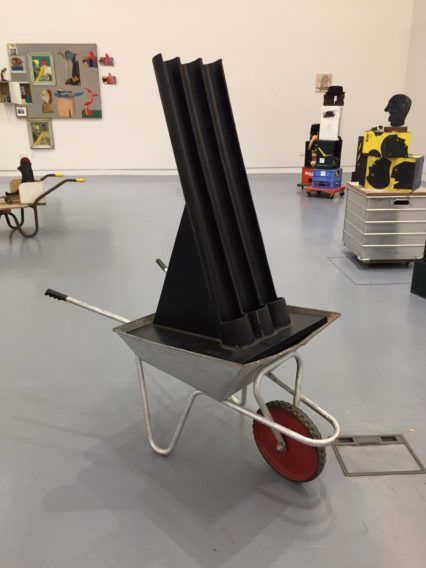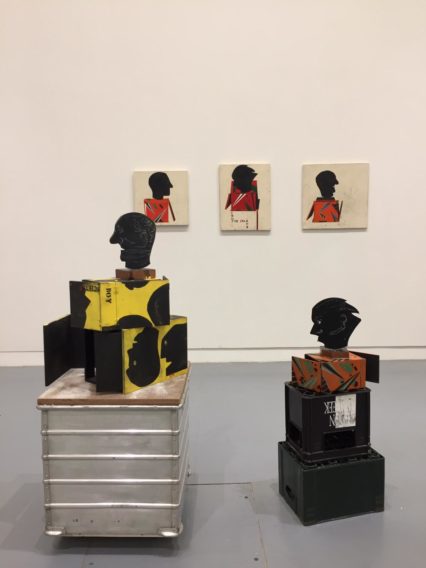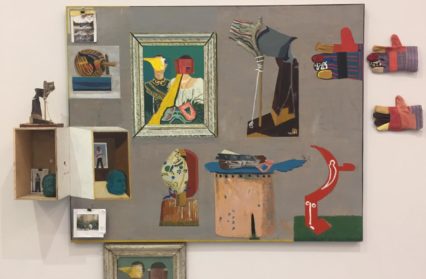Scott Baines reviews Trailer, the latest exhibition from Gareth Griffith, one of north Wales’s most influential artists, at Ty Pawb in Wrexham before it moves to Oriel Davies in January.
Before I left, I picked up four postcards. The smelliest was decorated with the aptly olfactory piece of ‘Ffagani’ but it smelt mostly of hydrogen peroxide. Or is it alkyl ketene dimer? Admittedly, I’m no chemist. These are the chemicals that emanate from newly pressed paper. As I took one of each such cards from the new exhibition at Tŷ Pawb entitled Trelar/Trailer, any sense of novelty was quickly dispersed. The objects exhibited are neither new nor old, they cross a temporal divide that contaminates and corrupts such notions of the new and the old, the past and the present. To complicate matters further, space is involved too.
 Although the exhibition for Trailer is oriented clockwise upon entry, any one of the pieces is so captivating as to distract the spectator’s attention from any simple notion of linearity. I was immediately drawn to ‘Ulysses Blake’ because of its inscription ‘ULYSSES – CAPTEN’. The Ulysses myth is only one of the beguiling motifs that runs throughout the room. An old Penguin edition of Homer’s Odyssey sits under a doorstop in the piece ‘Bertorelli’. The title is taken from an ice cream and coffee shop in Caernarfon where the artist, Gareth Griffith, acquired the painting that inspired it. At the other end of the room, ‘Ithaca’ is an astounding collaborative effort of deep imaginative literary interpretation. Leopold Bloom is illustrated thrice having his head severed, drawn among Joyce’s masturbation scene, Penelope waiting for Odysseus and the comeuppance of the suitors. I found myself re-turning to many of the objects, again and again. And the Latin prefix re- is something that defines the exhibition more than anything else.
Although the exhibition for Trailer is oriented clockwise upon entry, any one of the pieces is so captivating as to distract the spectator’s attention from any simple notion of linearity. I was immediately drawn to ‘Ulysses Blake’ because of its inscription ‘ULYSSES – CAPTEN’. The Ulysses myth is only one of the beguiling motifs that runs throughout the room. An old Penguin edition of Homer’s Odyssey sits under a doorstop in the piece ‘Bertorelli’. The title is taken from an ice cream and coffee shop in Caernarfon where the artist, Gareth Griffith, acquired the painting that inspired it. At the other end of the room, ‘Ithaca’ is an astounding collaborative effort of deep imaginative literary interpretation. Leopold Bloom is illustrated thrice having his head severed, drawn among Joyce’s masturbation scene, Penelope waiting for Odysseus and the comeuppance of the suitors. I found myself re-turning to many of the objects, again and again. And the Latin prefix re- is something that defines the exhibition more than anything else.
Recycling is the most preeminent noun that grabs the attention in association with it. None of the works exhibited in Trailer are in pristine condition, nor are they meant to be. Rather, they amalgamate as an unplanned, spontaneous, juxtaposing mêlée of statements. The unsaid difficulty is of course the ultimate unknowability of the meaning surrounding such statements, and the spectator’s aggrandisement of statements to suit their own personal interpretation. Many of these objects are weird and defy easy comprehension, and they should be respected as such: the contorted heads, the sedentary chariots, the empty storage boxes. They are the same but different; they are reiterated. This is the first and most significant connotation of the theories of Jacques Derrida that the exhibition presents to the spectator. In summary, every object contains ‘traces’ of every other, so that even when said object is completely obliterated from the world, other objects stand as a testament to its once impervious existence.
The second connotation is that of decapitation [de-caput; ‘off with the head’], used as a metaphor to evidence how the ‘head’ of the work – the title – can merge with the work itself. Similarly, the object of the exhibition title occupies the centre ground of the room, and in its mundanity is metamorphosed into an impossible object of history, just as there are impossible cuts to action in film. The wooden carts become chariots under the wall collection and in ‘Ja & Cerbyd Rhyfel/Chariot’. Whereas decapitation is an arguably tenuous metaphor regarding the chariots, the word is conferred an entirely tangible significance in relation to the severed heads.
‘Lwcame Lwcayou’ is an immediate signalling of the leitmotif, reiterated on the ‘Clasgliad Wal/Wall Collection’ in ‘Kaan’, the Baconesque triptych of ‘Ex’, ‘Edrych/Look’ and ‘Ffag’, in ‘Chohiminabox’ and in ‘Bwrdd/Table’. They are reminiscent first of the death sentences many Roman citizens endured under Caligula’s reign, being buried up to their neck and left to their sorry fate. But Griffith disclosed that the theme blossomed from a close encounter he had with a machete in Jamaica, an anecdote that usurps the Roman image, substituted for the Caribbean beaches of a Bond film. The machete is vertically hoisted upon the piece entitled ‘Penienent’, between the other phallic objects of ‘Pollock’s Stick’ and ‘Slab’. Freud posited in his essay Das Medusenhaupt that decapitation was a symbolic fear of castration. The desire to keep one’s head, (especially when all around, all are losing theirs) is similar experience of wanting to maintain oneself in the world: to reproduce, to ‘recycle’ your genes and for successive generations to recollect your achievements. This remembrance is of course the purpose of the mask of Agamemnon, another bodiless embodiment of history.
 Further underlying the presence of Jamaica in Trailer is the seminal Romantic printmaker, William Blake. He is a figure that makes his presence known in ‘Blake Dem A Loot’ and on the table of severed heads – his presumably being one of them. Blake painted many images of slaves, most notably in his Europe supported by Africa and America (1792). A plaster cast of his head was even made by the phrenologist James de Ville in 1823. Furthermore, the chariots are inspired by Jamaican pushcarts. The characterisation of the exhibition with this geographical theme is certainly one of autobiographical pertinence for the artist, but it also speaks to the wider theme of use and utility.
Further underlying the presence of Jamaica in Trailer is the seminal Romantic printmaker, William Blake. He is a figure that makes his presence known in ‘Blake Dem A Loot’ and on the table of severed heads – his presumably being one of them. Blake painted many images of slaves, most notably in his Europe supported by Africa and America (1792). A plaster cast of his head was even made by the phrenologist James de Ville in 1823. Furthermore, the chariots are inspired by Jamaican pushcarts. The characterisation of the exhibition with this geographical theme is certainly one of autobiographical pertinence for the artist, but it also speaks to the wider theme of use and utility.
What is of paramount importance in the Twenty First Century is that humanity does not repeat the actions of the last several hundred years, both ecologically and colonially. In other words, we cannot continue to enslave the planet or each other to our continuously recycled requirements of endless production and consumption. If these collective heads had the power of speech, they would erupt into an unsettling cacophony of the historical weight they represent. But it’s not all doom and gloom. Elsewhere, heads encapsulate a more optimistic situation, capitalising on their partial autonomy where they can.
In ‘Maja’, named after and influenced by Francisco Goya’s Le Maja Desnuda, a man bends between sagacity and adoration for a woman. The maja were the lower classes at the turn of the eighteenth century in Spain who dressed elaborately to conceal their class origins. The piece has a certain ersatz-esque eccentricity comparable to ‘Sickertz – Dau Artist Marw/Two Dead Artists’ among the wall collection. There is an obvious reference in the title to the Camden Town Group post-Impressionist Walter Sickert. Indeed, the amount of Griffith’s exophoric references that have already been touched upon to art and art history is a testament to the fact that an aesthetic scope drastically loses its meaning without the historisation and contextual framing necessary to it. Such a significant factor to the exhibition is articulated in ‘Loches/Shelter’, a piece recycled from a collaborative exhibition in Mostyn gallery in 2008.
Amidst such a flurry of reiterated and recycled objects, it is almost impossible to leave Benjamin’s Mechanical Reproduction unconsidered, and its famously acclaimed conclusion concerning the politicisation of art. Although Trailer certainly does not scream politics, there is more than a whisper of it. It is frequently glossed in my conversations with Griffith, where the topic ranges from the recent beheadings committed by jihadi extremists, through to the extreme crime rate that Amnesty International has uncovered in Jamaica. Discovering such extremities in a place that is meant to be so seemingly static is a fantastic feeling; that art can ‘move’, and subsequently move the spectator. The element of play located here is something that influenced the playground exhibition in the adjacent gallery, and Griffith himself notes that Picasso’s real aim was not to draw like Rafael, but like a child.
As mentioned near the introduction, the prefix re- is the defining feature of the work. But cor- also makes its presence felt: the correspondence and corruption of objects, their corporeality, the corpulence of certain heads. That so many themes should emanate from a single exhibition is representative of a rhetorical question of the self, and a desired one at that. Have I been empowered or overpowered? The power that the spectator has over any work of art can oftentimes be underestimated, but the multifarious nature of such an exhibition as this compliments this spectacular power of interpretation, which should never be denigrated. If memory is a cognitive recycling, the brain certainly produces many beautiful images with which to remember Trelar/Trailer.
You can find out more about the dates for Gareth Griffith’s Trailer here.
You might also like…
Nick Hornby has brought his Wonderland to the MOSTYN Gallery in Llandudno with Zygotes and Confessions. Here, Amy Briscoe reviews the dream-like exhibition, which is currently attracting an international audience online.
Scott Baines is a contributor to Wales Arts Review.












